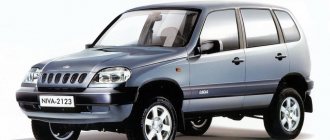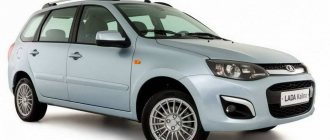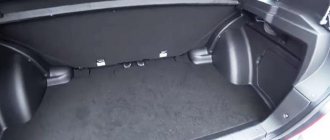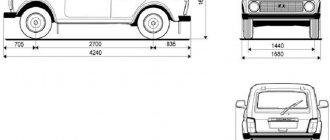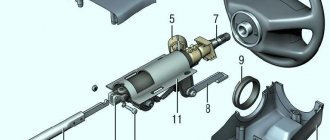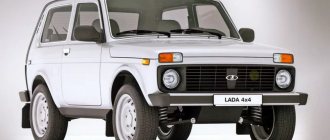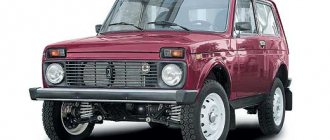Engine VAZ-21214
Engine modifications
VAZ-21213 "NIVA" (4x4) 4WD is a 3-door car with a 5-speed gearbox. Number of seats for driver and passengers: 5. Maximum possible speed is 132 km/h. Acceleration time to 100 km/h is 23 seconds. Average fuel consumption per 100 km is: in the urban cycle - 13.4 liters, on the highway - 7.8 liters, in the combined cycle - 9.8 liters. The volume of the fuel tank is 42 liters. A full tank is enough for approximately: 313 km when driving around the city, 538 km when driving on the highway, 429 km when driving the combined cycle. The maximum load capacity of the vehicle is 400 kg.
VAZ-21213 technical characteristics
| Years of manufacture | 1993-2000 |
| Body type | station wagon, 3-door |
| Number of seats | 5 |
| Other name | Niva |
| Wheel formula | Niva |
| Dimensions of VAZ-2121 | |
| Length | 3720 mm. |
| Width | 1680 mm. |
| Height | 1640 mm. |
| Wheelbase | 2200 mm. |
| Front wheel track | 1430 mm. |
| Rear wheel track | 1400 mm. |
| Ground clearance | 220 mm. |
| Wheel size | 175/80 R16 |
| Trunk volume | 265/980 l. |
| Curb weight | 1210 kg. |
| Permissible weight | 1610 kg. |
| type of drive | 4 x 4 with the ability to lock the center differential |
| Engine VAZ-21213 1.7 | |
| Brand | 21213 |
| Supply system | carburetor |
| Engine capacity | 1690 cm.3 |
| Power | 79 l/s. at 5400 rpm. |
| Maximum torque | 130 N*m at 3400 rpm. |
| Camshaft position | top |
| Number of cylinders | 4 |
| Number of valves | 8 |
| Cylinder diameter | 80 mm. |
| Piston stroke | 82 mm. |
| Compression ratio | 9,3 |
| Gasoline brand | AI-92 |
| Engine VAZ-21214 1.7 i | |
| Brand | 21214 |
| Supply system | distributed injection |
| Engine capacity | 1690 cm.3 |
| Power | 81 l/s. at 5000 rpm. |
| Maximum torque | 128 N*m at 4000 rpm. |
| Camshaft position | top |
| Number of cylinders | 4 |
| Number of valves | 8 |
| Cylinder diameter | 80 mm. |
| Piston stroke | 82 mm. |
| Compression ratio | 9,3 |
| Gasoline brand | AI-95 |
| Engine VAZ-21217 1.6 | |
| Brand | 21217 |
| Supply system | carburetor |
| Engine capacity | 1569 cm.3 |
| Power | 73 l/s. at 5400 rpm. |
| Maximum torque | 114 N*m at 3400 rpm. |
| Camshaft position | top |
| Number of cylinders | 4 |
| Number of valves | 8 |
| Cylinder diameter | 80 mm. |
| Piston stroke | 79 mm. |
| Compression ratio | 8,5 |
| Gasoline brand | AI-92 |
| Transmission VAZ-2121 | |
| Clutch | dry type |
| Transmission type | 5-speed manual |
| Transfer case | 2-stage |
| Front/rear brakes | Disc/drum |
| Steering | worm gear |
| Front suspension type | coil spring |
| Rear suspension type | coil spring |
| Performance characteristics | |
| Maximum speed | 137 km/h |
| Acceleration time to 100 km/h. | 137 km/h |
| Fuel consumption in the city/on the highway | 19 p. |
| Fuel tank volume | 43 l. |
dimensions
The modern VAZ 2121 Niva is still a compact SUV with a monocoque body, so the dimensions of the car are not very large. The length of the 2121 Niva is 3.74 m. The width and height parameters are also not particularly impressive:
- this SUV is 1.68 m wide,
- the height indicator is only slightly inferior to the width - 1.64 m.
Car salon
The high cross-country ability of the VAZ 2121 is due to the fact that it has good ground clearance. Despite its compact dimensions, the vehicle's ground clearance is 220 mm.
It is also worth paying attention to the VAZ 2131 model. The peculiarity of this car is that it has a 5-door body. In order to be able to install two additional doors, the body was lengthened by 50 cm. The remaining overall dimensions, such as height, width and ground clearance, remained unchanged.
VAZ-21214 engine modifications
| 21214-41 | modification with a power steering pump, with a welded steel manifold, YAZTA hydraulic supports, Euro 3. |
| 21214-34 | modification without power steering pump, with cast iron manifold, INA hydraulic mounts, Euro 3. |
| 21214-33 | modification with power steering pump, cast iron manifold, INA hydraulic mounts, Euro 3. |
| 21214-32 | modification with power steering pump, cast iron manifold, INA hydraulic mounts, fuel pipes for quick connectors, flywheel for clutch 215mm, Euro 3. |
| 21214-31 | modification with power steering pump, steel welded manifold, INA hydraulic supports, Euro 4. |
| 21214-30 | modification without power steering pump, with welded steel manifold, INA hydraulic supports, Euro 4. |
Changes in external and internal design
Visually, the Niva Fora differs from the basic version in several characteristic details. The first is the long front door. The second is the roof, which has become larger and higher due to the plastic lining on top. The appearance began to resemble the legendary Land Rover Defender, only in the upper part of the roof there are no additional small windows. The third difference is the spare wheel, which, due to its large size, does not fit under the hood and is installed on the rear door - so the Fora has become even more like a jeep.
On the first models, the wheel hung on a low-quality bracket, which caused a lot of inconvenience to the owners. To open the trunk, you first had to lift the spare tire and then move it to the side. If the weather was rainy, or there had been an off-road trip before, such manipulations always ended with soiled clothes. The designers took this drawback into account and equipped the bracket with a lever, by pulling which you can easily tilt the wheel to the side.
Welds and joints are practically invisible to the naked eye, and the strength of the body remains the same. The doors have additional handles with which rear row passengers can open the door.
In the cabin, the upholstery of the door panels and seats is made of ordinary materials; the former still lack additional pockets for small items. The salon is no different from the base model - the interior is completely consistent with the regular version of the Niva. The gearshift knob is just as uncomfortable, the steering wheel is VAZ. Ergonomics remained at a low level - modernization did not change anything significantly. You can try to add an air conditioning system, but this will not achieve a feeling of comfort.
Many car owners have a reasonable question: “Is it worth buying a Niva Fora?” This modification costs almost twice as much as the regular version of the car. The changes that the SUV has undergone are clearly not worth the money they are asking for. The Niva with five doors is also cheaper than the Fora. There is no point in overpaying for the long body and characteristics of the standard version of the car.
One of the most interesting and respected creations of the domestic automobile industry is the Niva car. This Soviet and then Russian SUV was highly popular and was even exported to other countries of the world. Based on it, a considerable number of modifications were created, many of which are little-known, but very interesting.
The first Niva rolled off the assembly line in 1977 and immediately won the hearts of motorists. Under the hood was an in-line engine with a capacity of 80 horsepower per 1.6 liter. It was equipped with a four-speed gearbox. Slightly different models were sent for import - with a 1.3-liter engine.
edit File processing manual
So, dear friend, you wanted to get a field. And obviously not for puffing fart steam along the highway. General recommendations for purchasing are the same as for Lada cars in the corresponding article, but I’ll hasten to cool your ardor: in stock configuration, a Niva is of little use for extreme conditions. That is, you can drive through shallow shit not far from civilization, but that’s where all the good things end. So, what do you need to climb all sorts of things?
1. Larger tires
(at least 29″), and not road ones, but mud ones.
Yes, they howl when driving on the highway. But as soon as the scene turns to shit, you immediately forgive them for the mockery of their ears. 1.1. Follows from 1: cutting arches
.
Large wheels hardly fit into standard arches, so they need to be trimmed a little. Or lift the car. Or both. 1.2 (optional) Also follows from 1: replacement of main pairs
in gearboxes.
As soon as you put on big shoes, the load on your engine and transmission increases, and the speedometer and odometer start to lie. Return the yak bulo - you need to change pairs. The standard gear ratio is 3.9, for 29″ you need 4.3, for larger diameters - Google the calculator. 1.3 (optional) The load on the axle shafts and drives
, however, will remain increased, so they should be replaced with reinforced ones.
But, in principle, if you don’t really want to go to hell and Israel, you can ride standard ones. 2. Strengthening body structures.
Power bumpers and sills at a minimum.
As well as crankcase and transfer case protection. There is nothing to do in the forest without them. You will understand this as soon as you gore the first stump. A winch is also mounted on the power bumper. It would also be nice to scald the side members: the loads on the body due to all sorts of dents with holes and potholes are quite heavy, and you obviously don’t want the car to be twisted by a screw, right? 3. Since we’re talking about the transfer case
: if possible, take a non-standard one, with a gear ratio of at least 3:1.
Compared to the standard one (which has 2.1) - heaven and earth. By the way, with such a transfer case you don’t have to change the GP, but you will need reinforced cardan shafts. 4. Winch.
Oh, how many times she naturally saved!
Mandatory, and with a force of at least 3T. It is optional to buy or make an anchor, because in an open field, suddenly, there is nothing to cling to. 5. Hijack and sandtrucks.
Without them there is absolutely nothing to do in the shitholes.
A hijack is a rack and pinion jack. Allows you to lift what you hooked by a meter, or even one and a half. Can work like a hand winch. Sandtracks are durable metal plates with hooks, about a meter long. They are needed to put under the wheels when you drive into liquid mud and skid. We lift it with a high-tech vehicle and put sandtrucks on it. Having covered the length, repeat the iteration, and so on until enlightenment, that is, climbing out. 6. Snorkel
and breather outlet.
If you are planning to storm the fords, you cannot do without this option. The snorkel will allow you not to drink water from the engine (which usually turns the car into real estate), and not to get water into the transmission units (which also turns the car into real estate, but not immediately). 7. Expedition trunk and overhead light.
Together, because one thing is usually placed on top of the other.
Do we remember point 1? Did you forget about the spare tire? Absolutely not ? Have you tried putting it back in place? What, it won't fit? Same thing. Usually everyone puts it there, on the expedition ship. And in general, in the case of a Niva, this is extremely useful, because the car is small, there is little space in the cabin, the trunk is symbolic, and people carry several voluminous backpacks with their tourist belongings. The overhead light is also extremely useful: not only are standard headlights completely insufficient in the forest and field at night (you obviously want an illuminated landscape not only from below and in front), but it is also the only way to illuminate yourself when storming a ford. Water easily gets into standard headlights, and if they are turned on, through sudden cooling it kills the lamps, and sometimes even the optical element along with it. 8. In the case of a carburetor field, electric fans
with a temperature sensor for the radiator (injection engines have them straight from the factory). And the native forced one - take it off and forget it like a bad dream. In the summer, the forced one simply doesn’t cope where you need to drive slowly and at high speeds (in shitty areas and traffic jams - quite often), and in the winter, because of it, the car warms up for about 20 minutes. So electric fans are our choice. In addition, in the event of a water obstacle, electric fans can and should be turned off, unlike forced fans, with which it is generally very undesirable to go into the water.
9. Take wheel chains with you..
That's about the minimum you need to feel like a tough shit climber. Not so great, but enough for the first time. In the next issue we will go over the rest of the tuning, of which quite a lot has come to market over the past 3 years.
UAZ or Niva suspension and addition to the off-road arsenal
UAZ or Niva, what to choose? Hunter's dependent leaf spring suspension transfers vibrations to the body very well. In terms of reliability and driving in mud, there are practically no complaints about it, just as there are no hints of comfort (it’s not for nothing that they called it a “goat”).
How to sharpen brake discs yourself? More details here..
We will show you how to independently adjust the beam of your car headlights here.
In terms of comfort, the Niva is definitely better. Judge for yourself: there is only a rear dependent suspension, while an independent system is installed at the front, so bumps and bumps are not overcome so harshly. VAZ offers owners some other nice bonuses: power steering, brakes with anti-lock brakes and emergency braking booster. The interior is trimmed with fabric, but there are no other frills here: what the Niva was 20 years ago, it remains the same, except that they began to install an electrical package in front.
With all this, this UAZ is finished even more modestly and minimalistically, one can only say about the power steering and washable floor covering and interior. The scarcity of the basic configuration is to some extent compensated by the possibilities of tuning and purchasing additional equipment (winches, luggage racks, protective bumpers, etc.)

